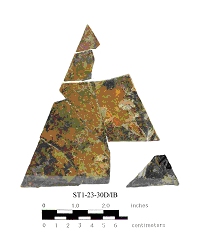Glass window fragment

Conservator’s Notes
Several triangular glass window panes were recovered from the St. John’s Site. These windows were cross-mended, treated in the early 1990s, and stored with the collections. The windows were pulled for exhibition at St. John’s in the newly constructed St. John’s museum and were once again examined by the staff of HSMC. Although the windows remained intact and the pieces were still oriented in their original packaging, the windows needed to be removed from their storage mounts and stabilized for display vertically. The windows underwent conservation treatment to accomplish this.
 The windows were previously treated and mounted using Mylar with a paper backing to hold the pieces in order while in storage. Over time, the paper adhered to the back of the glass fragments, and they could not be removed without more treatment. The glass was soaked and immersed in solvents, and carefully removed from the paper while carefully keeping all the pieces in order.
The windows were previously treated and mounted using Mylar with a paper backing to hold the pieces in order while in storage. Over time, the paper adhered to the back of the glass fragments, and they could not be removed without more treatment. The glass was soaked and immersed in solvents, and carefully removed from the paper while carefully keeping all the pieces in order.
The fragments were then cleaned and treated separately, removing any fragments of paper from the surfaces and consolidating the fragile surfaces with an acrylic co-polymer system. The glass was then re-mended to their original orientation, and strengthened for display.
The glass windows are displayed in the newly constructed St. John’s museum on the property of HSMC. The staff worked with the mount makers to display the windows vertically as they would have originally been used in the house at St. Johns.
 Curator’s Notes
Curator’s Notes
Glass windows were a symbol of considerable economic status. Many houses lacked glazing, while those that did have windows often had small, simple diamond shaped panes. The builder of St. John’s, John Lewger, was the colony’s secretary, essentially the second in command of the colony. His house was unusual in both its size and level of finish. His house had not only glass windows, but windows with elaborately shaped window panes also called quarells in the 17th century. These glass pieces were held in place with narrow, “H” shaped pieces of lead, not unlike modern stained glass windows.
St. John’s was one of the largest and best-built structures in the early Maryland colony. As colonial secretary, Lewger often hosted the Assembly at his house.
 |
 |
| Window leads from St. John’s | Window glass as displayed |


